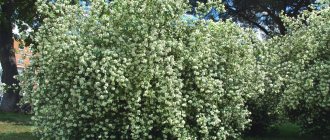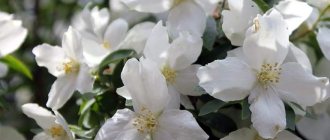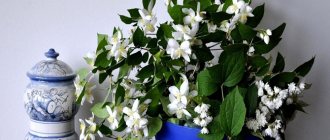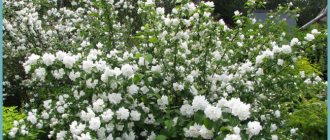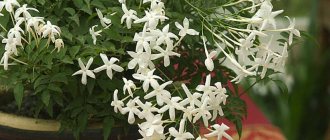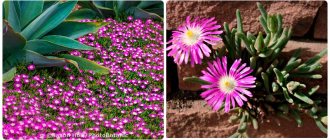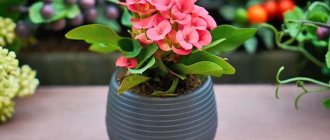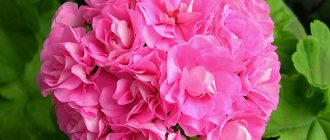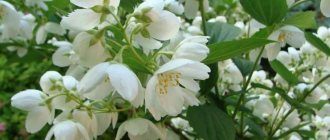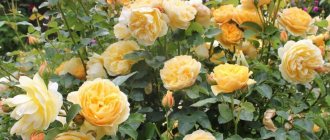Jasmine or mock orange - what usually grows in the country
Many gardeners, due to their external similarity and fragrant flowering, have combined these species under one name. In fact, mock orange and jasmine belong to different families. Jasmine is an evergreen member of the Olive family. It is the national flower of Indonesia, the Philippines and Pakistan. Mock orange belongs to the small-leaved hydrangea shrubs. The name in Latin is “Philadelphus”, which comes from the words “phileo” - “to love” and “adelphos” - “brother”, given for the closely adjacent opposite shoots.
For your information! There is a version that it was named after the nickname of the ancient Egyptian king Ptolemy Philadelphus. In ancient times, the loose core was removed from its branches and original smoking pipes were made. This is how the Russian-language name of the genus appeared, which should not be confused with a tropical plant.
Chubushnik crown - one of the most common varieties in summer cottages
What is the difference between jasmine and mock orange
Jasmine and mock orange - what's the difference? Jasmine is a symbol of purity and simplicity, glorified by ancient legends. Among the varieties there are both erect and climbing specimens. Jasmine is not just an ornamental plant; its petals are used as an additive to tea; special varieties are grown for essential oils, which are used in perfumery, cosmetology, aromatherapy, and medicine. Flowers for all these purposes are collected mainly at night or early in the morning. They begin to open as the sun goes down. The corolla of the flower is white or yellow, sometimes with a pink tint, a narrow long tube, inside of which the stamens grow.
What is the difference between mock orange and garden jasmine? Mock orange is called garden jasmine, or false jasmine. Its inflorescences are clusters of 3-9 large flowers from 2.5 to 7 cm in diameter. The main advantage is long-lasting, abundant flowering, which is why it is widely used in landscape design. The smell of some species is reminiscent of strawberries, pineapple, and some have a faint, subtle odor.
Note! Small-flowered ones usually smell stronger and brighter than those with large flowers, but the jasmine aroma attributed to this plant is not found.
Mock orange hedge
Jasmine loves warmth and grows in tropical and subtropical climates. His historical homeland is India. In Indonesia, where they decorate weddings, it is called melati, in the Philippines - sampaguita, and in Pakistan - chambeli. In South and Southeast Asia, streets are planted with it. And in Europe, the fields of Provence are famous, where raw materials for the legendary Chanel No. 5 fragrance have been grown for more than 90 years. The perfume-producing Italian town of Grasse also allocates territories for the cultivation of jasmine, but the cost of raw materials there is several times more expensive than in India or Morocco. Jasmine also grows in the warmest regions of Russia - the Caucasus and Crimea. True, only two species are cultivated and grow in the wild: yellow and real.
For your information! The aroma of mock orange also did not leave perfumers indifferent, but it is not so widely used. The most famous perfume with a bright, recognizable scent is Eau de Camille Annick Goutal. A. Goutal dedicated it to her daughter Camilla in 1983.
Mock orange is a deciduous plant that grows in Eastern Europe, South Asia, and North America. It is unpretentious, can survive on poor soils, tolerates relative shade, aridity, and damp soil, but stagnant water causes rot. It is frost-resistant, but the roots are protected by mulching for the winter. The only thing he can’t come to terms with is the saline soil.
During flowering, the bush turns into a white cloud. The shape and color of the leaves also serve decorative purposes. The leaves are ovate-lanceolate and turn lemon green in the fall or remain green until they fall off.
There is a golden variety, which is valued for its rare shade of crown.
Golden mock orange
Important! If the soil is waterlogged, at a depth of at least half a meter you need to create a drainage layer of gravel and broken bricks.
Features of stephanotis transplantation
When transplanting floribunda, you must follow the following rules:
- It is done in the spring, when there are no buds on the plant yet, no more than once every two years. In this case, transshipment is used while preserving the near-root earthen coma.
- To stimulate the plant to bloom, the new pot should be only a couple of centimeters larger than the old one.
- It is important that it is heavy enough. Otherwise, it will tip over under the weight of the massive plant.
- Its bottom is filled with expanded clay balls in a layer of 5 cm.
- The soil should be heavy, with a slightly acidic reaction. Its composition should be dominated by peat (almost half the volume), a third should consist of sand, and the remaining components - clay and leaf soil - should be contained in equal proportions. And when selecting ready-made soil mixtures, you need to focus on their acidity within 5-6 units with a nitrogen content of no more than 200 mg per liter.
- Watering of transplanted plants should be normalized, it is advisable to replace it with frequent spraying as much as possible. It is recommended to dissolve a small amount of growth stimulants in water.
How to distinguish mock orange from jasmine by external signs
The plants do look similar, but each can be identified if the differences are known. How to distinguish mock orange and jasmine by external characteristics? Just compare the stems. Jasmine has smooth, straight or curly stems, while mock orange stems are covered with thin gray-brown bark. Jasmine leaves are imparipinnate, that is, one blade does not have a pair, like a mountain ash, or trifoliate, arranged like a strawberry. The color is rich dark green. Mock orange has green leaves, some varieties have variegated leaves with a white lanceolate border, while young plants have oval leaves. The arrangement is opposite; at the same level, two leaves extend from the stem, growing opposite each other.
Mock orange (jasmine) - planting and care in open ground
The difference between mock orange and jasmine is also in the aroma and shape of the flowers. In jasmine they are regular in shape, can be single-colored or arranged in umbrellas, and usually have five petals or double buds. The petals are fleshy and are the ones that produce the oil. There is always a characteristic aroma. Inedible berries are formed in place of the buds. Mock orange can smell like citrus, pineapple, strawberry, or have no smell at all. The inflorescences are always lush and racemose. It blooms in May-June, in warm regions it can bloom again in the fall. As a rule, these plants are geographically located in different climatic zones, excluding some varieties.
Note! Mock orange has many beneficial properties, but due to its coumarin content, it is considered an allergen in some countries.
Are there any similarities between mock orange and jasmine?
Why is one plant mistaken for another? Each is shaped like a bush, but sometimes jasmines grow like vines. The similarity of some varieties during the flowering period and the aroma they emit are the reasons for the confusion. Mock orange smells so pleasant that this property can be attributed to a gift from the gods or angels, sung by ancient poets. When flowering, it seems to be covered with white foam. It grows where in winter the temperature drops to −25 °C; the lower temperature limit of its southern counterpart is 10 °C.
True jasmine: description and characteristics
In appearance, it can be distinguished from other plants of the same kind by the erect or curly smooth stems of the bush. They grow simple, trifoliate, dark green, odd-pinnate leaves. At the tip of the stem, buds of large flowers of regular shape bloom - umbellate or single, collected in corymbs. Depending on the species, the scutes may be on the tops or on the sides.
It is important to know. The highly concentrated, delicate and pleasant aroma of true jasmine flowers can cause headaches when growing plants in pots to decorate small spaces: rooms, offices.
The plant blooms profusely at the beginning of June or from the second ten days of the month after reaching 2-4 years of life. If you feed the crop, flowering will begin earlier. How jasmine blooms can be seen in the photo: the flower is endowed with a long corolla, like a narrow tube, with 2 thin threads inside. After fusion, the threads turn into berries that are not suitable for eating. The petals come in white, pink or yellow, and there are even more shades. Jasmine belongs to the ampelous cultivated species. Due to the lignification of part of the stem, it can serve as a decorative ornament. It does not require painstaking care, but pleases with flowers every year.
Types of mock orange
Chubushnik shneeshturm - description, planting and care
The name brings together more than 50 species, but only 5 are cultivated. Common mock orange reaches 3 m, blooms with loose racemose inflorescences, flower diameter up to 3 cm.
Common mock orange
Lemoine - a hybrid group, named after the creator V. Lemoine, includes about 40 varieties with a sweet, rich aroma and buds of about 4-5 cm. Terry varieties are resistant to frost. The most prominent representatives of the group:
- Bicolor. The variety has white flowers with a burgundy-pink center. The bush grows up to 2 m;
- Virgin. A terry variety that is associated with purity and innocence. Inflorescences have 5-7 medium buds. The bush grows up to 2 m;
- Firework. This is a bush 2.5 m in height, strewn with double inflorescences with a delicate aroma;
- Ermine robe. A low-growing variety with the longest flowering time, up to 50 days. Mantle is planted in hedges and is well formed by pruning;
- Belle Etoile. The height of the bush is up to 2 m, the buds have wavy petals and a pink center. The crown is spreading, winter hardiness is low. The variety is suitable for both single plantings and for the formation of hedges and compositions;
- Snowbell. A medium-sized shrub with a spherical shape. Blooms with double snow-white bells. The variety is undemanding, but does not tolerate waterlogging;
- Mont Blanc. Semi-double variety with a distinct strawberry scent. A low-growing bush with a large number of small flowers grows.
Mock orange Snowbell
Note! The definition of hybrid mock orange combines the creations of various breeders. Thus, the decorative qualities of the shrubs are increased, as well as winter hardiness and ease of care for some varieties.
Other equally popular varieties:
- Moonlight. A low-growing shrub with dark green, lush foliage, small cream flowers and a strong strawberry scent;
- Pearl. A low terry shrub with weeping branches and large pearlescent white inflorescences;
- Schneeshturm. Tall bush, up to 3 m, with arched branches and large inflorescences. Loves the sun, lack of light stretches out. The variety has low frost resistance; in cold winters the shoots freeze;
- Majorie. The flowers are creamy white and medium-sized. Tolerates temperatures down to −28 °C;
- Minnesota Snowflake. Hybrid from the coldest state in the USA. Obtained by crossing coronal and crown. From the parent bushes it inherited a spreading crown, as well as lush, densely double petals;
- Elbrus. A variety obtained from the crown mock orange. It has double flowers with a complete absence of scent.
Chubushnik Elbrus
For your information! The basis of many hybrids is the crown variety, which is famous for the beauty of its flowering and intoxicating aroma, known to agricultural technicians all over the world. Suitable for creating alleys, edges, tree and shrub groups, recommended for landscaping streets, school gardens and parks at medical institutions.
Top dressing
You can start feeding the bushes only a year after planting. To do this, use the following amount of mineral fertilizers:
- 15 g of potassium sulphide;
- 15 g urea;
- 30 g superphosphate.
All components are mixed in 10 liters of water, this amount is enough for two seedlings.
As for organic fertilizers, slurry has proven itself very well. One part of this fertilizer is diluted in ten parts of water. Feeding with slurry is carried out once a year.
You can also embed apple ash or birch wood into the soil under the mock orange. For one bush, 100 g of fertilizer is enough.
Most mock orange varieties bloom in June
Mock orange and other small white flowers make delicate, elegant bouquets that will decorate any interior.
Planting mock orange, caring for it and propagating
Why Chubushnik does not bloom, poor growth
Garden jasmine and mock orange are naturally shade-tolerant, not picky about the type of soil, and drought-resistant. But in the shade the branches stretch out, and poor soils without fertilizing lead to shrinkage and degeneration of flowers. To achieve an amazing result, it is better to choose an open place or slight partial shade. The best option is loamy soil types, provided with humus and moisture, and for heat-loving varieties - light soil with good drainage.
Note! Mock orange grows quickly, so it is better to choose seedlings in small pots. Seedlings from Holland are brought to stores in March, when all the specimens have not yet awakened. Sometimes it is difficult to tell if a plant is alive. The bark at the base should be gray, the shoots smooth brown.
The species reproduces by dividing the bush. To do this, they dig it up along with the roots and divide it in two, the halves are planted in prepared holes and watered. This procedure is carried out in the fall from early September to early October.
You can also propagate by layering; to do this you need to follow these steps:
- Select a young shoot of this year that has not yet bloomed, with 2 internodes, and cut it obliquely with a sharp knife.
- Make a straight cut 1.5 cm above the upper internode.
- Using scissors, cut 2/3 of the leaves.
- Prepare a container with turf soil and a 3-centimeter layer of sand on top.
- Make holes with a stick to a depth of about 1 cm, then insert the cutting, carefully strengthening it.
- Pour, cover with a bottle, film or glass.
For your information! For rooting, it is recommended to use the drug Kornevin, ventilate the greenhouse daily and spray the cuttings.
After rooting, the shelter must be removed. In warm climates, you can do without protection and root the cuttings outdoors.
Shoots prepared in the fall are planted in the spring.
Jasmine and mock orange shrubs are rarely propagated by seeds. The ovaries are usually cut off immediately after flowering to preserve the plant's vigor. To inherit varietal qualities, it is customary to propagate by shoots or by dividing the bush. But if such a need arises, by the end of summer the ovaries will turn into dry boxes. They should be placed in a plastic bag and stored in the refrigerator. Sow in late autumn before winter, covering with straw. In spring, young seedlings are hidden from the sun using lutrasil on a frame until they get stronger.
You can plant seedlings in a greenhouse or at home. If the soil is heavy, you need to dig a planting hole 40x40 cm. When planting, add two parts of compost, three - garden soil and one part of sand, a glass of ash and 1 tbsp. a spoonful of double superphosphate.
Care includes fertilizing, watering and pruning; the roots are insulated for the winter. Fertilize annually with one bucket of manure. Small fertilizing after flowering is possible. When planting, a young bush is immediately trimmed. Only weak shoots are cut to 1-2 buds, but already in the second year after flowering, all strong shoots are pruned to generative shoots, and weak stems are also removed and a crown is formed. From the third year, sanitary and formative spring haircuts are carried out.
Mock orange is rightfully considered one of the most beautiful garden plants in temperate climates. Easy care, lushness, and amazing aroma make it a favorite of landscape designers and ordinary gardeners.
Protection from pests and diseases
Ornamental shrubs, like all plants in the garden, are attacked and damaged by leaves and flowers: cockchafer, bark beetle, green leaf weevil, butterflies with larvae, spider mites, aphids. Spraying in the garden should be carried out immediately after the snow has melted, with preparations (according to instructions) such as HOM, Skor, Aktara, Bordeaux mixture, Fufanon, Keltana emulsion (0.1-0.2%), Phosfamide (0.2 %), Senpai. The second chemical treatment is carried out before the buds open , when the air temperature is set to + 20°C. You can get rid of 80% of pests and diseases with Fufanon with the presence of the fungicide Skor.
Bush pruning
To create a lush and fragrant jasmine bush, in addition to regular care and systematic watering, the plant should be pruned. Moreover, this should be done correctly and systematically.
Rules for pruning mock orange:
- Pruning is best done while the plant is in a vegetative state, that is, in the spring.
- Those branches that are significantly longer than the rest need to be cut off at the root. Branches of medium length - half.
- Using special scissors, it is necessary to remove all branches on which flowering does not occur. In this way, the so-called “anti-aging pruning” is carried out.
- The central trunk of an adult bush needs to be shortened by 40-60 centimeters.
